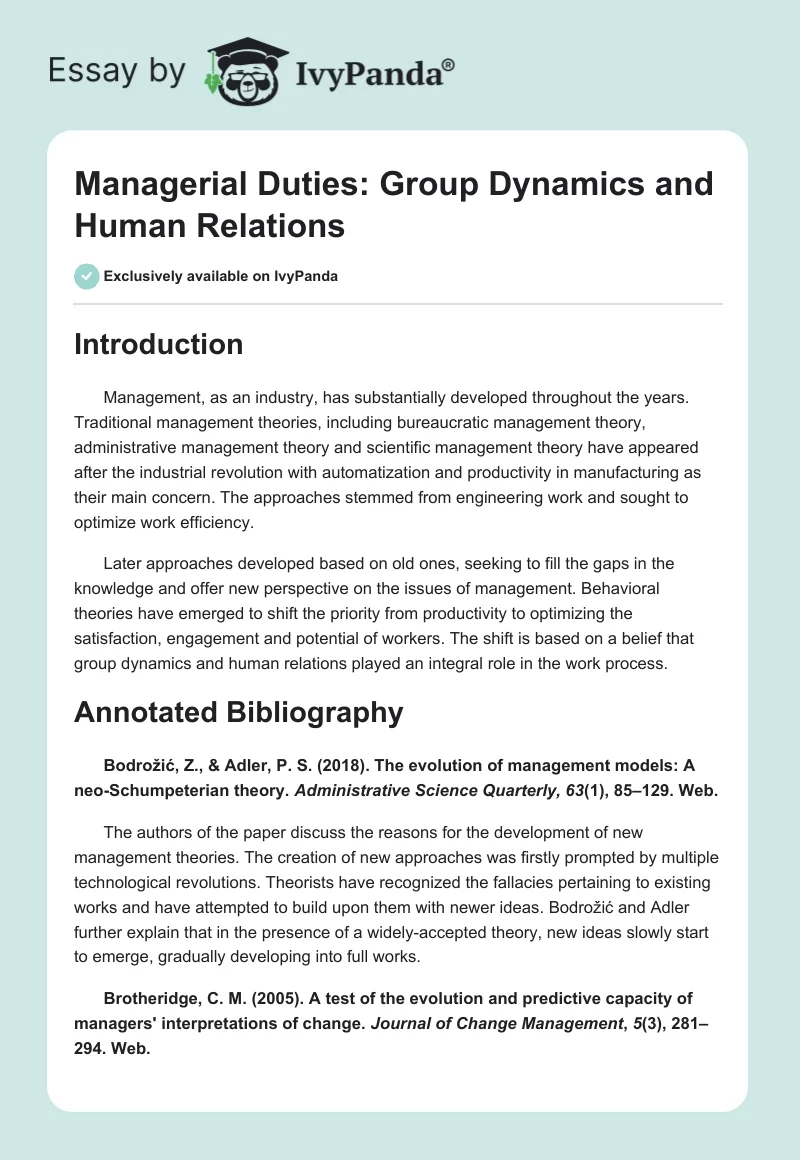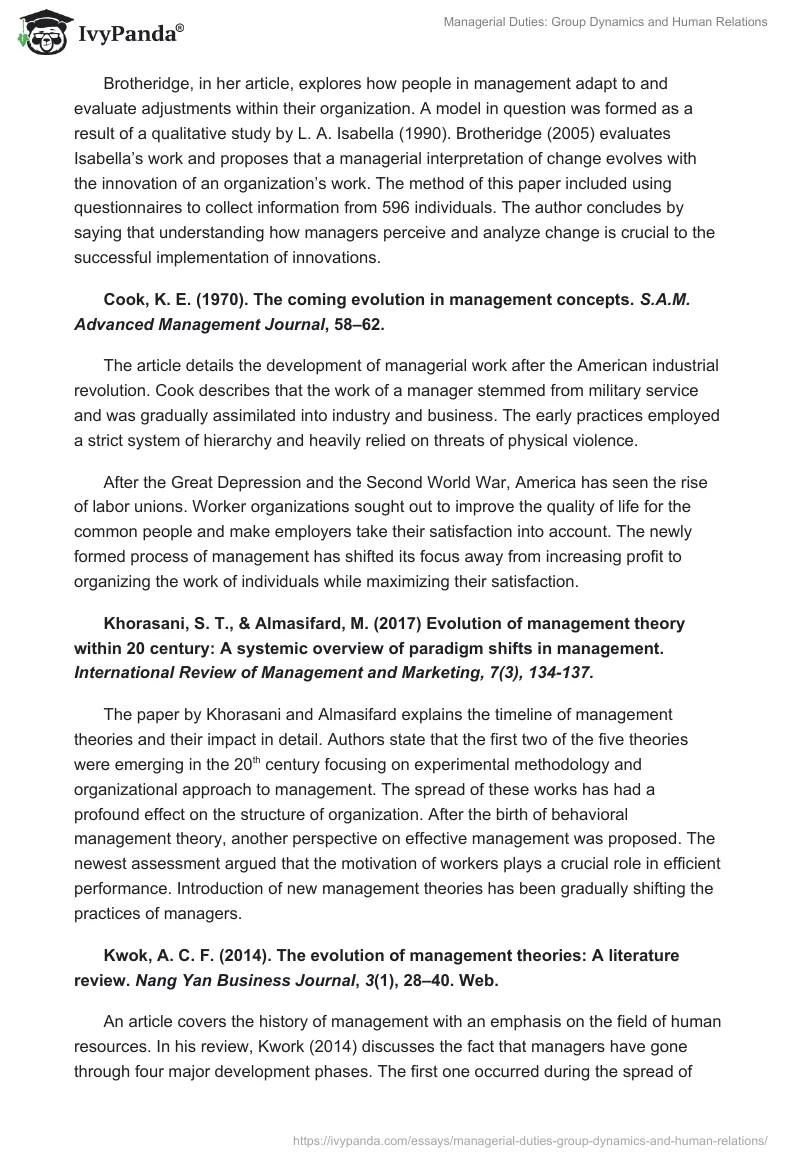Introduction
Management, as an industry, has substantially developed throughout the years. Traditional management theories, including bureaucratic management theory, administrative management theory and scientific management theory have appeared after the industrial revolution with automatization and productivity in manufacturing as their main concern. The approaches stemmed from engineering work and sought to optimize work efficiency.
Later approaches developed based on old ones, seeking to fill the gaps in the knowledge and offer new perspective on the issues of management. Behavioral theories have emerged to shift the priority from productivity to optimizing the satisfaction, engagement and potential of workers. The shift is based on a belief that group dynamics and human relations played an integral role in the work process.
Annotated Bibliography
Bodrožić, Z., & Adler, P. S. (2018). The evolution of management models: A neo-Schumpeterian theory. Administrative Science Quarterly, 63(1), 85–129. Web.
The authors of the paper discuss the reasons for the development of new management theories. The creation of new approaches was firstly prompted by multiple technological revolutions. Theorists have recognized the fallacies pertaining to existing works and have attempted to build upon them with newer ideas. Bodrožić and Adler further explain that in the presence of a widely-accepted theory, new ideas slowly start to emerge, gradually developing into full works.
Brotheridge, C. M. (2005). A test of the evolution and predictive capacity of managers’ interpretations of change. Journal of Change Management, 5(3), 281–294. Web.
Brotheridge, in her article, explores how people in management adapt to and evaluate adjustments within their organization. A model in question was formed as a result of a qualitative study by L. A. Isabella (1990). Brotheridge (2005) evaluates Isabella’s work and proposes that a managerial interpretation of change evolves with the innovation of an organization’s work. The method of this paper included using questionnaires to collect information from 596 individuals. The author concludes by saying that understanding how managers perceive and analyze change is crucial to the successful implementation of innovations.
Cook, K. E. (1970). The coming evolution in management concepts. S.A.M. Advanced Management Journal, 58–62.
The article details the development of managerial work after the American Industrial Revolution. Cook describes that the work of a manager stemmed from military service and was gradually assimilated into industry and business. The early practices employed a strict system of hierarchy and heavily relied on threats of physical violence.
After the Great Depression and the Second World War, America has seen the rise of labor unions. Worker organizations sought out to improve the quality of life for the common people and make employers take their satisfaction into account. The newly formed process of management has shifted its focus away from increasing profit to organizing the work of individuals while maximizing their satisfaction.
Khorasani, S. T., & Almasifard, M. (2017) Evolution of management theory within 20 century: A systemic overview of paradigm shifts in management. International Review of Management and Marketing, 7(3), 134-137.
The paper by Khorasani and Almasifard explains the timeline of management theories and their impact in detail. The authors state that the first two of the five theories emerged in the 20th century and focused on experimental methodology and organizational approach to management. The spread of these works has had a profound effect on the structure of the organization. After the birth of behavioral management theory, another perspective on effective management was proposed. The newest assessment argued that the motivation of workers plays a crucial role in efficient performance. The introduction of new management theories has gradually shifted the practices of managers.
Kwok, A. C. F. (2014). The evolution of management theories: A literature review. Nang Yan Business Journal, 3(1), 28–40. Web.
An article covers the history of management with an emphasis on the field of human resources. In his review, Kwork (2014) discusses the fact that managers have gone through four major development phases. The first one occurred during the spread of automatization of production and the growth of employee discomfort. The next change happened with the emergence of worker unions and the shift in management priorities. The latest adjustments in the field are intricately connected with the process of world globalization and its effects on manufacturing.
Kwork (2014) also covers the range of philosophers and thinkers who contributed to the developments in management. The earliest are noted to be Adam Smith, David Ricardo, and Charles Babbage. Smith and Ricardo both laid out the basic principles of labor management. The men argued that the division of work would increase its productivity. Kwork (2014) details the traditional management theories, including the Bureaucratic management theory, Scientific management theory, and Administrative management theory.
Matsudaira, K. (2019). The evolution of management. Communications of the ACM, 62(10), 42–47. Web.
Kate Matsudaira (2019), in her article, details her climb up the management ladder. The author describes her personal experience with the profession and particular skills that were necessary each step of the way. Matsudaira (2019) highlights the importance of communication and the ability to remove oneself from the direct process, instead focusing on coordinating the efforts of others. The article draws attention to the values of modern management and the aspects of managerial work that are the most important.
Nelson, K. L., & Svara, J. H. (2014). The roles of local government managers in theory and practice: A centennial perspective. Public Administration Review, 75(1), 49–61. Web.
The paper by Nelson and Svara (2014) explains the evolution of a manager in the work of local government. Authors argue that the popular narrative of the management in this sphere has downplayed the importance of the position and misinterpreted its contribution. During history, the position of a manager in governance has been redefined multiple times, creating confusion over its original purpose and duties. Nelson and Svara (2014) declare that management was highly involved with practical policy advice and community leadership.
Management was used to directly communicate with the public, hearing its concerns, but the necessity of such involvement was a point of debate. In the post-war period, managers have improved their public presence and fostered a cooperative relationship with the community. Afterward, the manager’s role gradually became more widely recognized as interchangeable in connecting the government and the public.
Whysall, Z., Owtram, M., & Brittain, S. (2019). The new talent management challenges of Industry 4.0. Journal of Management Development, 38(2), 118–129. Web.
The article argues that the changing environment of business has brought about the newest industrial revolution and the need to evaluate the implications of this event is necessary. By conducting in-depth interviews with HR personnel, they have found out that the gap between work requirements and the employee’s professional capabilities is increasing at an unprecedented rate. The authors emphasize the need to address the issue and develop new methods of talent development.
Conclusion
Having the ability to examine the leading works in the field, I find the behavioral theories to be the most relevant in today’s environment. The need to motivate and improve other employees is as high as it has ever been. In the chapter of class reading discussing the challenges of current management, worker dissatisfaction is said to correlate with poor performance and high turnover rates. The ability to communicate, develop human resources and organize workflow in an effective and fulfilling manner is, in my opinion, the core skills a successful manager should master.
The theorist that I find to be particularly insightful on the subject is Mary Parker Follett. Her assessment of the nature of management allowed many future professionals to see their work in a new light. Mary was one of the first theorists to propose that the process of problem-solving should be accomplished with the help of workers. The dynamic approach to tackling various emerging tasks presents a solid foundation to handling the challenges of the new age.


